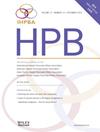Invasive intraductal oncocytic papillary neoplasms (IOPN) and adenocarcimoma arising from intraductal papillary mucinous neoplasms (A-IPMN) of the pancreas: comparative analysis of clinicopathological features, patterns of recurrence and survival: a multicentre study
IF 2.7
3区 医学
Q2 GASTROENTEROLOGY & HEPATOLOGY
引用次数: 0
Abstract
Background
Intraductal oncocytic papillary neoplasms (IOPNs) of the pancreas are now considered a separate entity to intraductal papillary mucinous neoplasms (IPMN). Invasive IOPNs are extremely rare, and their recurrence patterns, response to adjuvant chemotherapy and long-term survival outcomes are unknown.
Methods
Consecutive patients undergoing pancreatic resection (2010–2020) for invasive IOPNs or adenocarcinoma arising from IPMN (A-IPMN) from 18 academic pancreatic centers worldwide were included. Outcomes of invasive IOPNs were compared with A-IPMN invasive subtypes (ductal and colloid A-IPMN).
Results
415 patients were included: 20 invasive IOPN, 331 ductal A-IPMN and 64 colloid A-IPMN. After a median follow-up of 6-years, 45% and 60% of invasive IOPNs had developed recurrence and died, respectively. There was no significant difference in recurrence or overall survival between invasive IOPN and ductal A-IPMN. Overall survival of invasive IOPNs was inferior to colloid A-IPMNs (median time of survival 24.4 months vs. 86.7, months, p = 0.013), but the difference in recurrence only showed borderline significance (median time to recurrence, 22.5 months vs. 78.5 months, p = 0.132). Adjuvant chemotherapy, after accounting for high-risk features, did not reduce rates of recurrence in invasive IOPN (p = 0.443), ductal carcinoma (p = 0.192) or colloid carcinoma (p = 0.574).
Conclusions
Invasive IOPNs should be considered an aggressive cancer with a recurrence rate and prognosis consistent with ductal type A-IPMN.
侵袭性导管内癌细胞乳头状瘤(IOPN)和导管内乳头状黏液瘤(IPMN):临床病理学特征、复发模式和存活率:一项多中心研究
导管内肿瘤性乳头状瘤(IOPN)目前被认为是导管内乳头状粘液瘤(IPMN)的一个独立实体。侵袭性 IOPNs 极其罕见,其复发模式、对辅助化疗的反应和长期生存结果尚不清楚。本研究纳入了全球 18 个学术胰腺中心因浸润性 IOPN 或 IPMN 引发的腺癌(A-IPMN)而接受胰腺切除术的连续患者(2010-2020 年)。比较了浸润性 IOPN 与导管型和胶体型 A-IPMN 的治疗效果。共纳入 415 名患者:其中侵袭性 IOPN 20 例,导管型 A-IPMN 331 例,胶样 A-IPMN 64 例。中位随访 6 年后,分别有 45% 和 40% 的浸润性 IOPN 复发和死亡。侵袭性 IOPN 和导管 A-IPMN 的复发率和总生存率没有明显差异。浸润性 IOPN 的总生存率低于胶状 A-IPMN (中位生存时间为 24.4 个月对 86.7 个月,P = 0.013),但复发率的差异仅有边缘意义(中位复发时间为 22.5 个月对 78.5 个月,P = 0.132)。考虑到高风险特征后,辅助化疗并未降低 IOPN(p = 0.443)、导管癌(p = 0.192)和胶样癌(p = 0.574)的复发率。浸润性 IOPN 应被视为一种侵袭性癌症,其复发率和预后与导管 A-IPMN 一致。
本文章由计算机程序翻译,如有差异,请以英文原文为准。
求助全文
约1分钟内获得全文
求助全文
来源期刊

Hpb
GASTROENTEROLOGY & HEPATOLOGY-SURGERY
CiteScore
5.60
自引率
3.40%
发文量
244
审稿时长
57 days
期刊介绍:
HPB is an international forum for clinical, scientific and educational communication.
Twelve issues a year bring the reader leading articles, expert reviews, original articles, images, editorials, and reader correspondence encompassing all aspects of benign and malignant hepatobiliary disease and its management. HPB features relevant aspects of clinical and translational research and practice.
Specific areas of interest include HPB diseases encountered globally by clinical practitioners in this specialist field of gastrointestinal surgery. The journal addresses the challenges faced in the management of cancer involving the liver, biliary system and pancreas. While surgical oncology represents a large part of HPB practice, submission of manuscripts relating to liver and pancreas transplantation, the treatment of benign conditions such as acute and chronic pancreatitis, and those relating to hepatobiliary infection and inflammation are also welcomed. There will be a focus on developing a multidisciplinary approach to diagnosis and treatment with endoscopic and laparoscopic approaches, radiological interventions and surgical techniques being strongly represented. HPB welcomes submission of manuscripts in all these areas and in scientific focused research that has clear clinical relevance to HPB surgical practice.
HPB aims to help its readers - surgeons, physicians, radiologists and basic scientists - to develop their knowledge and practice. HPB will be of interest to specialists involved in the management of hepatobiliary and pancreatic disease however will also inform those working in related fields.
Abstracted and Indexed in:
MEDLINE®
EMBASE
PubMed
Science Citation Index Expanded
Academic Search (EBSCO)
HPB is owned by the International Hepato-Pancreato-Biliary Association (IHPBA) and is also the official Journal of the American Hepato-Pancreato-Biliary Association (AHPBA), the Asian-Pacific Hepato Pancreatic Biliary Association (A-PHPBA) and the European-African Hepato-Pancreatic Biliary Association (E-AHPBA).
 求助内容:
求助内容: 应助结果提醒方式:
应助结果提醒方式:


